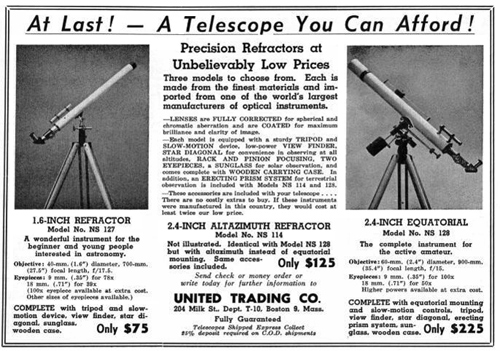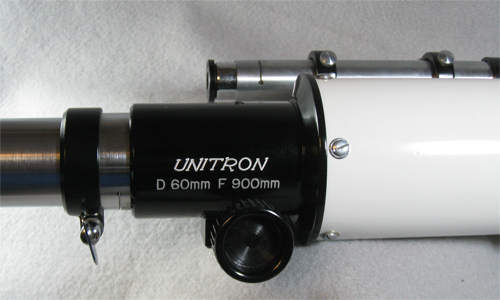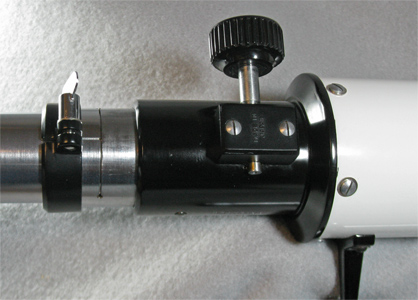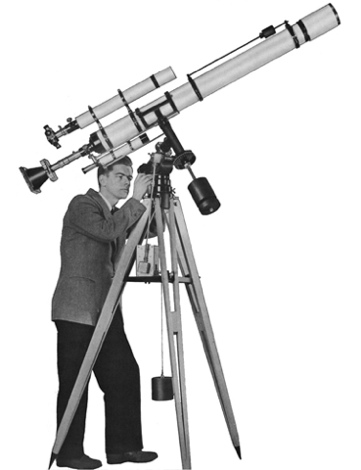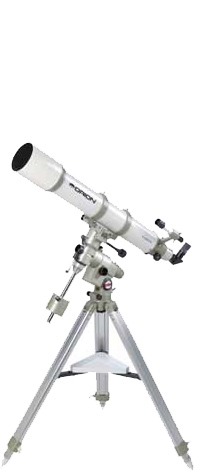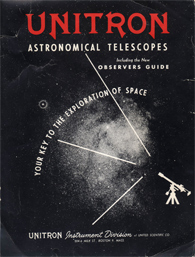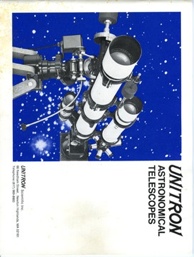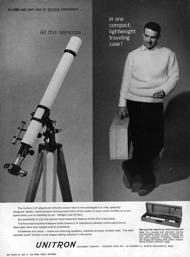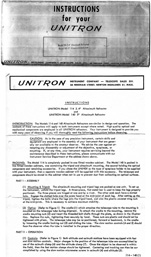Unitron Notes & Interesting Articles Index
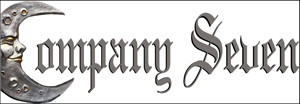
Unitron Model 114 - 2.4" (60mm) Achromatic Telescope
“among the preferred choices of those who could afford a good introduction to visual astronomy”
-
A discontinued product, posted for information purposes by Company Seven and with a historical perspective about the company who made it.
The information and illustrations here are from literature show the Unitron Model 114 telescope that are in Company Seven’s museum collection.

Preface: in July 2010 Company Seven acquired the Unitron telescope featured in this article for our collection. This is not the first Unitron to cross our threshold over recent decades, but is the first to be permanently retired to our display. The owner of Company Seven has been on a mission for decades to quietly promote science education through astronomy. We do this by helping to develop and sustain regional astronomy clubs, by donating equipment and expertise to start new astronomy programs overseas for elementary and junior high school age children, locally with our own observatory and showroom, and by the conservation and public display of telescopes and other instruments that have been worthy of note for attracting youth to space since the beginning of the Space Age.
Right: Unitron Model 114 - 2.4" (60mm) achromatic refracting telescope with the UNIHEX attached. This shows it displayed inside within an observatory dome (yes a real observatory is inside our showroom!) alongside a few of the other antique telescopes in our collection (87,379 bytes).
The other telescopes are (left to right): Criterion RV-6 Newtonian reflecting telescope of 1962, Meade Model 826C 8" f/6 Newtonian telescope of 1984, and a Celestron 8 Schmidt-Cassegrain telescope of about 1974.
Click on image to see enlarged view (285,881 bytes).
In terms of mechanical quality, consistency, and comparative comprehensiveness of the system UNITRON was among the better telescopes sold in the USA that were manufactured in Japan and distributed in the Americas from 1951 to about 1992. These telescopes were geared for the amateur astronomer and school science class markets. As Unitron prospered their offerings grew from the initial smaller models including the 60mm telescope shown here, to more complicated models including our own Unitron 3 inch photo-equatorial as displayed at Company Seven, up to massive refracting telescopes made for permanent observatory installations. These instruments provide good performance in their day, beautiful appearance - they looked good just standing there, and were versatile given their well integrated system of accessories. While our community was saddened by the demise of the telescopes production, the Unitron company continues to distribute microscopes, and other equipment. There are other companies bearing the Unitron name, including one distributing hearing aids, but these are not the Unitron that sold telescopes.
Company Seven had been keen to acquire a Unitron Model 114 for our display since these are among the few landmark production telescopes that gave thousands of people their introduction to visual astronomy. In our display the Unitron Model 114 telescope represents the pinnacle of the smaller refracting telescopes, among the best that a beginning amateur throughout the 1950's and into the 1960's might have aspired to own. In February 2011 Company Seven acquired a Unitron Model 142 3 inch Achromatic Photo-Equatorial Telescope for our collection. In August 2014 we acquired a late production Unitron Model 132 4 inch (102mm) Equatorial Refractor, and later we added the more common Unitron Model 152 4 inch (102mm) Achromatic telescope to our exhibit; these 4 inch telescopes are exhibited alongside our Model 142/145 for comparison and nearby our Model 114. We deem each of these to be significant enough to preserve and display.
- Cost of a new Unitron Model 114 2.4 inch telescope = $125
- Average cost of rent per month was $80.
- The average cost of gasoline was 20 cents per gallon.
- Average cost of a new car was $1,700.
- The median family salary (wages before taxes) per week was $75.
- Easy Payment Plan: was a form of credit granted to customers who completed a simple credit application and were qualified by Unitron. These customers placed their order for a telescope accompanied with a minimum payment of 25 percent of the balance due. Optional accessories amounting to $50 or more could also be bundled into this payment plan. The customer received the telescope and accessories, then paid the balance due plus a 6 percent carrying charge over the next 12 month period. Customers who could pay the balance due in less than 12 months would receive a proportional refund of 4 percent of the original carrying charge. The first payment was due 30 days after the instrument was delivered, and if the customer sent payment for the remaining balance then no carrying charge would be applied at all.
As explained in the 1956 catalog “If your choice is the UNITRON Model 152, the 4" Equatorial priced at $785, the required down payment is only $196.25 with 12 monthly payments of $52.”
- Layaway Plan: the customer ordered the telescope but the order was held at Unitron. In the meantime the customer made payments (at least $10 each in the 1950's) and when the total had been paid then the telescope would be sent to the customer. Aside from the cost of the equipment and shipping there was no additional interest, carrying charges or fees.
- 2 inch diameter eyepiece can show as much as 2.9x the area seen in a 1.25 inch eyepiece, or 5x the area of a 0.965 eyepiece
- 1.25 inch diameter eyepiece shows 1.7x the area of a 0.965 inch eyepiece
- 0.965 inch eyepieces can show almost two thirds the area that can be seen in 1.25, and one fifth the area that can be seen in 2 inch eyepieces
- 1951 United Trading Company, 204 Milk Street, Boston 9, Massachusetts
- 1952 UNITRON, United Scientific Company, 204-206 Milk Street, Boston 9, Massachusetts
- 1957 UNITRON Instrument Division of United Scientific Co., 204-206 Milk Street, Boston 9, Massachusetts
- 1960 UNITRON Instrument Company, Telescope Sales Division, 66 Needham Street, Newton Highlands, Massachusetts 02161
- 1965 UNITRON Scientific, Inc., 66 Needham Street, Newton Highlands, Massachusetts 02161
- 1970 UNITRON Instrument Company, Telescope Sales Division, 66 Needham Street, Newton Highlands, Massachusetts 02161
- 1975 UNITRON, 66 Needham Street, Newton Highlands, Massachusetts 02161
- 1981 UNITRON Instruments, Inc., 175 Express Street, Plainview, NY 11803 (then a subsidiary of Ehrenreich Photo Optical Industries, Inc.)
- 198? UNITRON Instruments, Inc., 101 Crossways Park, West Woodbury, NY 11797 (still a subsidiary of Ehrenreich Photo Optical Industries, Inc.)
- 1992 UNITRON Inc., 170 Wilbur Place, PO Box 469, Bohemia, NY 11716
Later production telescopes sold in the USA may be accompanied by literature indicating the seller was "Unitron Instrument Company - Microscope Sales Division". This lack of continuity could not have helped the viability of the telescope product line in the USA.
 "The Green Lights Are Flashing For Johnny Carson" article by Gilbert Millstein with photograph by Curt Gunther in the 8 June 1963 issue of the weekly TV Guide Magazine. The late Johnny Carson came to the hobby of astronomy and accumulated several telescopes including the Unitron Model 114 2.4 inch Achromatic refracting telescope. In this interview Mr. Carson was shown in only one of the several photos taken alongside his Unitron telescope by photographer Curt Gunther. Over his tenure as host of "The Tonight Show" and in other ways he popularized the science of astronomy. He was formally recognized by the professional astronomy community when the asteroid "3252 Johnny" was named after him.
"The Green Lights Are Flashing For Johnny Carson" article by Gilbert Millstein with photograph by Curt Gunther in the 8 June 1963 issue of the weekly TV Guide Magazine. The late Johnny Carson came to the hobby of astronomy and accumulated several telescopes including the Unitron Model 114 2.4 inch Achromatic refracting telescope. In this interview Mr. Carson was shown in only one of the several photos taken alongside his Unitron telescope by photographer Curt Gunther. Over his tenure as host of "The Tonight Show" and in other ways he popularized the science of astronomy. He was formally recognized by the professional astronomy community when the asteroid "3252 Johnny" was named after him.
This is the scanned copy of original magazine* in Company Seven's Archives. This article is protected by Copyright. We obtained permission from TV Guide Magazine, LLC to scan and host this article from the original in our archives for the benefit of our readers and for display alongside the Unitron 114 in our museum collection. Please do not distribute this without permission. Download size is 5,675,333 bytes (an Acrobat ".pdf" file).
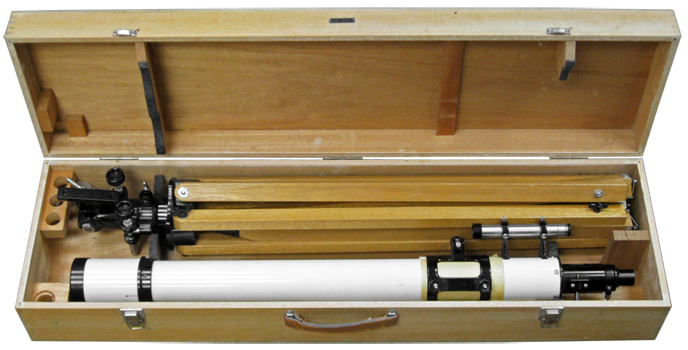
Unitron 60mm telescope, Model 114 cased as it arrived at Company Seven |
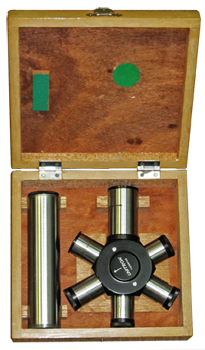
UNIHEX A with four eyepieces as it arrived at Company Seven |
Above: Unitron 60mm Model 114 cased telescope of the Company Seven collection. This instrument is complete much as it was delivered to the original
owner. To the right is the UNIHEX A holding the provided 0.965" (24.5mm) diameter eyepieces that would have otherwise been stored with the cased telescope.
Click on images to see enlarged views (995,286 and 786,153 bytes).
This Unitron 2.4 inch telescope is unusually complete and intact consisting of the 2.4 inch (60mm) aperture f/15 achromatic refractor optical tube assembly (or OTA). This set includes the 114 series Altazimuth Mount wood Tripod. The set includes a 6x finder telescope, and a set of four (4) eyepieces to provide a range of useful magnifications with the telescope. All of the components fit neatly into a wood case. When this telescope was ordered the customer had a choice of accessories either the 90 degree inclined Star Diagonal (for astronomy uses) and with an inline Image Erecting Prism (for terrestrial uses), or with the UNIHEX. This telescope includes the UNIHEX accessory that permits the user to store as many as six (6) eyepieces at the rear of the telescope, dialing in one eyepiece after another thus varying the magnification at will. The UNIXEX too is provided with its own separate wood box. This system is so lightweight that an adult can carry the assembled telescope and mount outdoors through an average doorway with little effort.
The optics of this telescope and of all the mechanical components are original, intact, and functioning well. The accessories too appear issued with this telescope. Cosmetically we rate the telescope as appearing near new with the only signs of use being some flaking of the black paint on the tripod leg tips. Unfortunately there are no easily accessible serial production numbers on these telescopes. While one of the accessories dates to about 1972 or later, an accessory could have been interchanged among other telescopes, or replaced years after the telescope was sold. The solid wood telescope and mount case arrived with some minor damage to the support braces inside, but these were professionally repaired and installed back into place. The case needed only some cleaning and conditioning, the same for the leather carrying strap/handle of the case. Since our general policy is to conserve antiques - to clean and protect them from decay, we display this telescope among our collection at our showroom cleaned but otherwise as it arrived.

 Background: the telescopes marketed in the Americas under the trademark 'UNITRON' were produced by Nihon Seiko Kenkyusho, Ltd. of Nozawa, Setagaya-ku, Tokyo, Japan. This company and its affiliates manufactured telescope and other scientific instruments. We have no substantial information about how Nihon Seiko Kenkyusho came to be, or when they developed their line of fine achromatic refracting telescopes. However, the company was established at least as far back as the the mid 1930's, then furnishing fine achromatic telescopes of at least up to 125mm aperture to universities under the POLAREX and Seiko Scope trademarks. By 1951 the company had emerged from the ashes of the war and offered an their first assortment of what was to become an extraordinarily well integrated and accessorized line of telescopes, mounts, and accessories.
Background: the telescopes marketed in the Americas under the trademark 'UNITRON' were produced by Nihon Seiko Kenkyusho, Ltd. of Nozawa, Setagaya-ku, Tokyo, Japan. This company and its affiliates manufactured telescope and other scientific instruments. We have no substantial information about how Nihon Seiko Kenkyusho came to be, or when they developed their line of fine achromatic refracting telescopes. However, the company was established at least as far back as the the mid 1930's, then furnishing fine achromatic telescopes of at least up to 125mm aperture to universities under the POLAREX and Seiko Scope trademarks. By 1951 the company had emerged from the ashes of the war and offered an their first assortment of what was to become an extraordinarily well integrated and accessorized line of telescopes, mounts, and accessories.
Right: the Unitron 2.4 inch Model 114 telescope of the Company Seven Museum Collection.
This instrument has the UNIHEX A accessory attached holding the four provided eyepieces (309,461 bytes).
Click on images to see a striking enlarged view (1,014,604 bytes).
Japan had become the butt of 1950's quality control jokes, "made in Japan" was generally not considered a compliment. But Japan's industries improved, they became innovators, and the Japan of the late 1960's into the 1980's came to dominate the production of small moderate to excellent quality optics including telescopes, cameras and microscopes. Unitron appealed to the more demanding clientele, a limited portion of the marketplace. And over the years Unitron was to stay loyal, one could argue mired, to their principles.
The aspect of their history in the USA commenced when United Trading Company acquired the rights to distribute the Nihon Seiko telescopes and their accessories. United Trading was founded by Lawrence Fine with offices and a shop at 204 Milk Street, Boston 9, Massachusetts. Soon after going into business United became United Scientific Co. and developed an acronym under which the telescopes might be more readily recognized, the trade name UNITRON.
Simultaneously the telescopes continued to be marketed in western block nations of Europe and most Commonwealth nations (Australia, New Zealand, etc.) under the trade name 'POLAREX'. Of course in Japan these sold under their trade mark 'Seiko Scope'. Some smaller quantity production lots of telescopes were made by Nihon Seiko Kenkyusho under other trade names, but these are not anywhere near as common as those bearing UNITRON or POLAREX trade names. This particular 2.4 inch telescope is among those listed in the Nihon Seiko catalog under the "Senior" series.
The astronomical telescopes product line offered initially included models built upon the 1.6" (40mm) and 2.4" (62mm) optical tube assemblies. The product line would include Altazimuth heads, German Equatorial heads, wood tripods for portable use, steel piers for permanent installation of the larger models, eyepieces and accessories. Gradually the line expanded to offer 2" (50mm) and 3" (75mm) models. In May 1953 the 4" (102mm) models were announced soon followed by the observatory class 5" (125mm) and 6" (150mm) optical tube assemblies. Given the limitations of the crown and flint glass available then, in order to provide good performance the better refractors made from the 19th through the mid 20th century are lengthy beasts, typically with focal ratios on the order of f/15. This is the ratio of their lens diameter to their focal length, hence 2.4 x 15 = 36 inches or about 900mm. So even our comparatively small Unitron 2.4 inch telescope is challenging to work around with when housed within a six foot diameter observatory dome, as we display it at Company Seven.
New accessories and minor adjustments continued as the telescope line got its legs in the marketplace. In May 1955 'UNIHEX' was announced as the name for Unitron's new six position rotary eyepiece holder; the competition to come up with the name was won by three amateur astronomers and each was awarded a UNIHEX. While each entrant in the competition was sent as a gift The Nature of the Universe, a book by Fred Hoyle published in 1950 that is based on his series of radio talks about astronomy presented on the BBC. Adjustments included changes of minor accessories (eyepieces, etc.) availability, and of models designations. For example 2.4 inch models are usually referred to as '2.4' inch or occasionally as '60mm' in the literature. However, at least some of the telescopes made between 1954 to 1955 are engraved 'D 62mm F 900mm', by the mid 1950's this would be changed and remain 'D 60mm F 900mm' for some twenty years. Some later production 2.4 inch telescopes from the mid 1970's are labeled 'D 65mm F 900mm' on their focuser and objective lens cell. We have measured the true clear aperture only of the one in our collection shown in this article, so we cannot be certain about whether or not this was merely a labeling issue or if their apertures really did vary over time from 2.36 up to 2.55 inch. If the apertures really did vary then this amounted to as much as a perceptible 17% difference in light gathering power.
Provided objective lens covers slipped onto the front and were embossed with "UNTITRON" in lettering; these could be a white painted cover with lettering in red (mid 1950's), but finally settled into black with white lettering. Most were minor changes, but none that made one component or the other obsolete.
There was little in the way of true innovation with the telescopes, Nihon Seiko accumulated wisdom from other accomplished makers then integrated these ideas into their production - and did so with class. What Nihon Seiko did manufacture was made after careful thought, with a high degree of precision, and made of appropriate materials smartly engineered to work well and save weight. Each component was assembled by caring craftsmen who obviously took pride in their work. Nihon Seiko developed an integrated system with a good selection of optional accessories. These accessories increased the versatility of the telescopes, while some of these items simply made it easier or more comfortable to use the telescope. These telescopes were produced in quantities large enough so that the economies of scale with Japanese labor allowed their prices to remain below that of the most highly regarded competing refractors (Zeiss, Goto, Tinsley, etc.). With numerous quality control steps throughout the process the factory insured every telescope made would be a garner admiration and confidence, as well as high performance for the new owner.
Throughout production changes to the equipment were not arbitrarily made and so parts support remained excellent even beyond the formal demise of the telescopes distribution, for those who choose to restore any Nihon Seiko telescope. It is not uncommon to find parts bearing the various logos on one used telescope since especially in the years following the discontinuation of production owners salvaged parts from damaged telescopes. So for example one might find a POLAREX labeled 1980's telescope with a 1950's 'Seiko' labeled lens cover and with other parts labeled UNITRON.
The first United advertisement announced their 1.6 and 2.4 inch aperture telescopes. This was submitted late in 1951 for placement into the October issue of Sky and Telescope, soon after this was followed by ads in other issues and in Scientific American magazines too.
One amateur posted a comment that nicely puts these instruments into perspective in contemporary times:
The US distributor was then marketing as United Trading Co., before UNITRON became the registered trademark (116,544 bytes).
Click on image to see enlarged view ((192,267 bytes).
In time Unitron ads would appear in other publications too including Popular Mechanics and Science Digest too.
In 1952: the cost of this telescope set with two eyepieces and a standard diagonal (before the UNIHEX was available) was $125 plus shipping. This was a long time ago; President Harry S. Truman was still in office, the Korean War was still on. So to gain some understanding about the times and how the cost of this telescope compared to other typical expenses of 1952:
In 1952 the Model 114 telescope cost the average household nearly two weeks salary! If we refer to the U.S. Government Consumer Price Index Inflation Calculator we see $125 in 1952 had about the same buying power as $1,029 in 2010, when this telescope arrived at Company Seven. Incidentally, the $585 of 1985 corresponds to $1,186 in 2010. So even the 'entry level' telescopes were quite an investment for the average consumer.
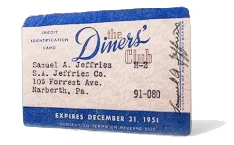 By 1952 the first and only credit card in widespread use, Diners Card, had only about 40,000 card holders; this is a small percentage of the some 41 million families in the US at the time. So merchandisers offered other ways to help consumers buy their product. In 1954 Unitron instituted both their “Easy Payment Plan” and ̶Layaway Plan”. The offering of financing or layaway products was not unprecedented even in the telescope market as other companies too offered similar plans at one time or another.
By 1952 the first and only credit card in widespread use, Diners Card, had only about 40,000 card holders; this is a small percentage of the some 41 million families in the US at the time. So merchandisers offered other ways to help consumers buy their product. In 1954 Unitron instituted both their “Easy Payment Plan” and ̶Layaway Plan”. The offering of financing or layaway products was not unprecedented even in the telescope market as other companies too offered similar plans at one time or another.
Getting The Points Across: During the mid 1950's the most noteworthy competitors of Unitron's refracting telescopes were the Newtonian style reflecting telescopes and parts including those made by Cave Optical Company, Criterion Co., Edmund Scientific. So in 1955 Unitron unveiled a new part of its sales strategy that included humorous cartoons lampooning those bulky and heavier telescopes, and some competing refractors too. These are a few of those cartoons drawn for Unitron sales literature by the talented and acclaimed illustrator Ken Muse (b. 28 Apr. 1925, d. 19 Jun. 2010):
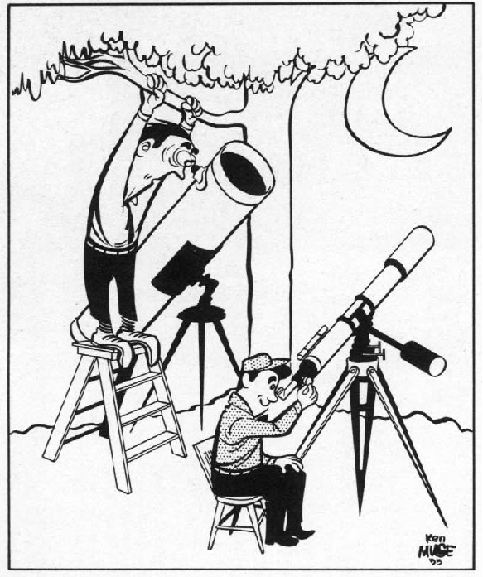
Mocking the inconvenience of reaching the eyepiece of a Newtonian telescope |

Giving up 'awkward and heavy' for comfortable and easier to use |
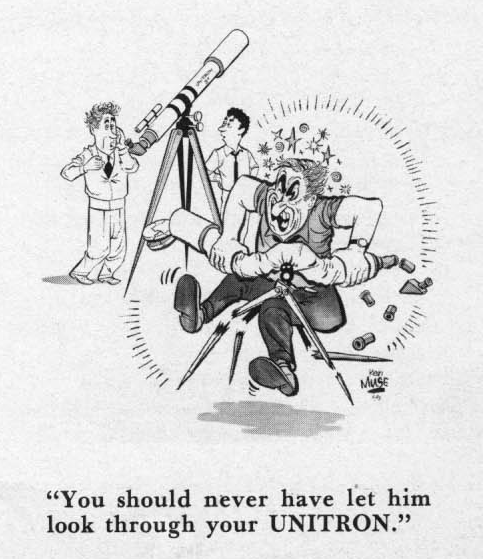
Self-explanatory |
Above: cartoons drawn in 1955 for the Unitron catalog and other sales literature by illustrator Ken Muse (38,353 then 43,524 and 38,401 bytes).
Click on images to see enlarged views (in order 204,980, 225,445, and 203,227 bytes).

Unitron developed comprehensive catalogs and hand-out literature focused on the more popular models. Unitron published their first Observers Guide and Catalog explaining each of their telescope models, their accessories, and with a brief observing guide for amateur astronomers. This was followed in 1956 by a revised and updated a forty-one (41) catalog that appeared similar but that also included customer testimonials and astrophotographs taken by Unitron owners. When we look at Unitron literature we are struck by the lack of information about the optical tubes and mounts weights and dimensions; it leaves us wondering how many people ordered a Unitron only to be shocked upon arrival by its size.
By the late 1960's plans were in the works to build even larger observatory based instruments and the first of these was the 8" (200mm) model. The largest model was developed in the late 1980's and these were the 225mm (8.86) telescopes.
Objective Lens: Throughout the 1950's and into the 1960's many lens makers offered achromatic telescopes, but no other western bloc nation had a manufacturer that offered a telescope as well made and functional, and with a price as moderate (given the performance) as these made by Nihon Seiko. The Nihon Seiko achromatic refracting telescope objective (front lens) employ an air spaced two lens, one group arrangement. The design derives from the Zeiss E-Objektiv, a refinement of the original doublet achromatic lens that was developed by German optician Joseph von Fraunhofer (b. 6 Mar 1787, d. 7 Jun 1826). This lens employs one element made of BK7 (borosilicate crown) glass precisely matched to work with the SF10 (a high index flint) glass component. In order to attain acceptable performance the focal ratio is f/15 fairly long by todays standards. By the 1920's Zeiss production included E-Objektiv 60mm telescopes similar to this Model 114 complete with gear driven altazimuth mounts, wood tripod, case, and in the customer's choice of either f/14.2 (Telex Codeword Asedabais, No. 511071) and in f/17.5 (Asalven, No. 511071).
Right: Objective Lens of the Unitron 2.4 inch telescope. Note the aperture engraved reads '60mm', and red anti-tampering paint (32,992 bytes).
Click on image to see enlarged view (289,095 bytes).
The two lens elements are kept apart at the nominal distance from one another by aluminum foil spacers. The three spacers are laid in at the edges and between the lenses, 120 degrees apart and have no perceptible adverse impact on performance. The foil is of the thickness determined by the lens design prescription. The lens elements and spacers are carefully slipped into a cylindrical lens cell and this is all held together by a retaining ring, the retaining ring is held in place by three bolts. As an anti-tampering measure each is dabbed with red paint so that if anyone tampers with the screws then the paint will be marred thus voiding any warranty. Signs of tampering giving one pause to consider whether or not the lens orientation may have been changed so that it may no longer be working at its best. The entire lens cell slips onto the optical tube, and is bolted into place by surrounding flat head screws.
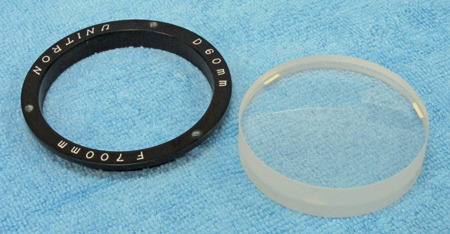
Above: similar Unitron 2.4 inch (60mm x 700mm) doublet objective lens elements shown together as installed, and apart to reveal both elements
Mouse over the image to see alternative view (76,772 and 76,967 bytes).
 When observing at moderate magnifications then the primary three colors of the spectrum will appear to be at focus to the eye. However, the two types of glass used to make theses lenses can only bring two of the three primary colors to focus since not all the wavelengths pass through the lens similarly. Achromatic objectives can bring either red and green or green and blue to focus. In this lens design red and green are at focus, while blue is slightly out. So when observing contrasting objects at very high magnifications such as the limb of the Moon, a bright star against a background of space, the dark branch of a tree contrasted against a light blue sky, then the areas where dark and light objects meet will appear with a slight violet halo. The planets for example do not appear as natural in color as they might with a more advanced apochromatic objective; Jupiter and Saturn appear a bit yellowish than when viewed through the achromat than with an apochromatic system (refractor or reflecting) where they may appear milky white.
When observing at moderate magnifications then the primary three colors of the spectrum will appear to be at focus to the eye. However, the two types of glass used to make theses lenses can only bring two of the three primary colors to focus since not all the wavelengths pass through the lens similarly. Achromatic objectives can bring either red and green or green and blue to focus. In this lens design red and green are at focus, while blue is slightly out. So when observing contrasting objects at very high magnifications such as the limb of the Moon, a bright star against a background of space, the dark branch of a tree contrasted against a light blue sky, then the areas where dark and light objects meet will appear with a slight violet halo. The planets for example do not appear as natural in color as they might with a more advanced apochromatic objective; Jupiter and Saturn appear a bit yellowish than when viewed through the achromat than with an apochromatic system (refractor or reflecting) where they may appear milky white.
In photography too, in color or even in monochromatic (black and white) imaging sharpness is undermined, and bright stars will appear a bit bloated. This caused by the halo of secondary color that does not focus within the same area of the disc as does the red and green components.
Left: zoomed-in Digiscope of an Egret taken with a pocket camera. Before zooming in onto the Egret the image appeared well, but just lacking some 'snap'. As the camera zoomed in then the image shows chromatism (violet false color) more and more obviously, especially pronounced where light and dark areas contrasts exist. The violet cast overall and the color fringing come from the lens of the pocket camera used to take the picture (124,684 bytes).
Click on the image above to view enlarged close up of the Egret where the violet fringing will be more apparent (132,351 bytes).
Regardless, chromatism was a common issue for most refracting telescopes and telephoto lenses manufactured into the 1970's since the apochromatic refractive systems up to this time were costly and complicated to make - and even the best of the time could not equal what was to follow.
| Optical Performance Of The Unitron 2.4 Inch x 900mm Objective | ||||||||||||||||
|
||||||||||||||||
Above: Table above expresses optical properties including color correction in Nanometers at various Fraunhofer color lines (C to G).
The G violet color is farthest from focus; this is why contrasting objects observed at high magnification appear with violet halo.
For additional information about where the Fraunhofer lines correlate on the spectrum see below:

The Nihon Seiko lenses are so smoothly figured and polished to meet the nominal prescription that the final degree of spherical aberration of these Nihon Seiko achromatic lenses is quite good so visual images appear sharp and clear so any residual false color is not that problematic to the novice observer.
AR Coatings: prior to 1935 all refractive lenses were made with no protective or anti-reflection treatments; the bare glass was exposed to the air or cemented to other lens components. So up to this time a notable amount of the light (4 to 6 percent per surface) approaching a lens was reflected off each lens surface - front AND back too! Consider an easy example for a moment - what do you see when you walk by a window pane? Your reflection! There is enough light reflected off that glass surface so that you can discern the image. The same thing was happening in telescopes, eyepieces, camera lenses - but worse. Since optical instruments and lenses consist of multiple elements of glass, there was the tendency not only to reflect light off the first lens surface but also to reflect light back and forth between uncoated air-spaced elements in the system. This not only decreased overall light throughput, but often resulted in 'ghost' or secondary images showing up on film or to the eye; an astronomer might be seeing a star in the field that was not really there.
Dr. Alexander Smakula (b. 9 Sep. 1900, d. 17 May 1983) led the team at the Carl Zeiss AG company at Jena that developed T-optic, the first anti-reflection coatings process devised for lenses. This was patented on 1 Nov. 1935 but kept a military secret throughout the following year. The first generations were a purplish tinted microns-thin layers of magnesium fluoride (MgF2) a metallic salt. When precisely applied in a vacuum chamber to the lens surface this reduces the amount of light reflecting off of a glass surface and thereby increases cumulative light throughput. These coating reduce undesirable reflections of light between glass elements thus increasing contrast and reducing the potential for 'ghost' images. This was a noteworthy achievement in optics, and it kept Zeiss camera lenses and more sophisticated optics at the forefront of technology in the 1930's. Initially only the more critical optics were treated, some of these are marked 'T' for transparenz. Over time even optical lens components of devices intended for routine uses (eyeglasses, binoculars, etc.) were coated.
By the mid 1940's the MgF2 coatings technology was implemented in routine production of most better optical components by manufacturers world-wide. The early Nihon Seiko telescopes predate their adoption of the MgF2 coatings, so when looking into the lens from outside the telescope one can see the whitish reflections clearly. Gradually the MgF2 antireflection coatings were adopted as the standard treatment for all their objective lenses, their eyepieces, and accessories (UNIHEX, DEUTRON, etc.). Some of these coatings may appear almost invisibly, given away only by a subtle violet tint while other lenses have a much more pronounced violet tint. We at Company Seven can not be sure of why there were differences, though we speculate it might have to do with changes of sourcing for parts or changes of coatings laboratories hired over time, or it could be a coater was inconsistent. We occasionally experience inconsistencies even today, particularly with some of the more sophisticated mirror and lens coatings.
Eyepieces: a telescope is a light funnel that gathers light and forms one image. Eyepieces are basically magnifying lenses that are attached onto the focuser of a telescope to enlarge the image. The working magnification, numerous qualities of the image (field of view, clarity, degree of chromatism, etc.), and the comfort of the user while observing (eye relief) are determined not only by the qualities of the telescope but also of the eyepiece.
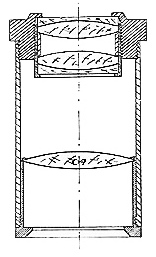 The eyepieces designs provided by Unitron included the Ramsden (sometimes termed Modified Achromatic), a design formulated in 1782 by scientific instrument maker Jesse Ramsden. The Kellner (designed b Carl Kellner in 1849) is another popular choice, basically an improved Ramsden. Both the Ramsden and Kellner are economical general purpose eyepieces that when made well satisfy most novices however, the Ramsden introduced perceptible false color that some people may wrongly attribute to originating in the telescope objective lens. Given the f/15 focal ratio of the Unitron telescopes makes less demands of an eyepiece than faster designs, these eyepieces were suitable for most amateurs. For the more demanding clients there were optional Orthoscopic (design devised by Ernst Abbe of Carl Zeiss in 1880) eyepieces available too. The Orthoscopic is highly regarded for its uniformity of magnification (lacking distortion) across the entire field of view when used with systems of f/7 and longer. When made well the Orthoscopic provides superb contrast and definition thereby making it an optimum choice for high resolution applications including observing the planets, double stars, the Moon, etc.
The eyepieces designs provided by Unitron included the Ramsden (sometimes termed Modified Achromatic), a design formulated in 1782 by scientific instrument maker Jesse Ramsden. The Kellner (designed b Carl Kellner in 1849) is another popular choice, basically an improved Ramsden. Both the Ramsden and Kellner are economical general purpose eyepieces that when made well satisfy most novices however, the Ramsden introduced perceptible false color that some people may wrongly attribute to originating in the telescope objective lens. Given the f/15 focal ratio of the Unitron telescopes makes less demands of an eyepiece than faster designs, these eyepieces were suitable for most amateurs. For the more demanding clients there were optional Orthoscopic (design devised by Ernst Abbe of Carl Zeiss in 1880) eyepieces available too. The Orthoscopic is highly regarded for its uniformity of magnification (lacking distortion) across the entire field of view when used with systems of f/7 and longer. When made well the Orthoscopic provides superb contrast and definition thereby making it an optimum choice for high resolution applications including observing the planets, double stars, the Moon, etc.
Right: One of the more interesting eyepieces ever distributed by Nihon Seiko in profile (20,747 bytes). From design in Company Seven's Archives.
The UNITRON 1.6 and 2.4 inch telescopes could accept interchangeable eyepieces of either 0.965 or 1.25 inch in diameter, although the standard four eyepieces provided with the set were 0.965. The 0.965 inch standard was referred to as the "Japanese" standard in some literature however, this standard was typical for telescopes made in the late 19th and early 20th centuries and predated Japan's involvement in optics.
When originally introduced the 60mm Altazimuth telescopes were sold for $125 and furnished with two 0.965 inch diameter eyepieces: the 9mm and 18mm. The standard drawtube tip fitting would accommodate 0.965 accessories (diagonal, etc.). By 1956 these telescopes were provided with a set of four eyepieces as standard equipment: 9mm Achromatized Symmetrical, 12.5mm Kellner, 18mm Kellner, and 25mm Huygens. Telescopes delivered (as this one) with UNIHEX would accept one optional 1.25 inch eyepiece. By 1963 Unitron included a new Achromatic Amplifier with the telescope, this is a negative or 'Barlow' lens that could be attached onto the barrel of the UNIHEX or the standard extension sleeve. When installed the Achromatic Amplifier increased the effective focal length of the telescope by a factor of about 2x, thus doubling the magnification of each eyepiece.
By the late 1980's most new amateur telescopes, even introductory models, were built to accept at least 1.25 inch diameter eyepieces. Companies including Celestron that offered 'Cometron' series telescopes with 0.965 targeted to the entry level consumer found the American customer and reviewers showed disdain for the old reliable standard in favor of the larger 1.25 inch eyepieces. The more advanced amateur and professional telescopes (not that too many professional astronomers ever look through a telescope anymore) incorporate focusers that can accept the even larger 2 inch diameter eyepieces. The attraction of the larger and larger eyepieces has to do with: 1. the potential for wider fields of view, and 2. improved eye relief.
In addition to magnification and quality of the image presented, the eyepiece determines the actual field of view; the area that can be seen. The field of view most accurately can be calculated when knowing diameter of the opening within the eyepiece barrel where the telescope image plane and eyepiece planes meet (Field Stop). Company Seven's measurements of Unitron eyepieces show how the differences in maximum area that can be observed compare among the three popular eyepiece standards:
Optional eyepieces in the Unitron line from 1955 included: 0.965 - 4mm Orthoscopic, 0.965 - 5mm Orthoscopic, 0.965 - 6mm Orthoscopic, 0.965 - 7mm Achromatized Symmetrical, one 1.25 inch eyepiece the 40mm Kellner-Monochro*, and one 2 inch 50mm Kellner. By the mid 1980's Unitron offered a greater selection of 1.25 inch diameter eyepieces than they offered 0.965 inch models. By 1985 the 2 inch offerings continued to show only one, the 60mm Kellner. The offerings varied somewhat over the years but the choices for the larger telescopes in particular included some 'upscale' 2 inch diameter eyepieces including the 55mm Plossl, and a 32mm Erfle wide angle eyepieces. But by the mid 1980's none of these eyepieces could compete for the attentions of dedicated observers against superior and more versatile eyepieces by competitors, most notably the innovative TeleVue Optics.
-
* this was a 1.25 inch diameter 40mm 'Kellner-Monochro' eyepiece thus could be used on the 60mm telescope models only when the telescope was equipped with the UNIHEX.
Each air spaced element was treated with magnesium fluoride anti-reflection coatings to improve light throughput and to reduce the possibility of ghost images. This subdued undesired reflections otherwise it was possible to have one brighter star reflect back and forth between eyepiece elements, thus giving the misleading appearance as though there were other stars in the field of view. The interior of each eyepiece barrel is painted anti-reflection black. The end of the machined eyepiece barrels are threaded to accept optional thread-on filters.
While the provided focal lengths of the eyepieces never varied over the years, the mix of models varied slightly. For example in most years the provided 25mm was a Kellner but later this was substituted for with a Ramsden. The telescope in Company Seven's collection came with the original four 0.965 inch diameter eyepieces (described below):
Right: Eyepieces provided with our Model 114 alongside three additional eyepieces in our display (95,568 bytes)
Click on the image to see enlarged view (100,004 bytes).
| UNITRON .965" eyepieces provided with this Model 114 telescope | |||||||||||||||||||||||||||||||||||||||||||||||
|
| These are optional UNITRON 1.25" & 2" eyepieces. Of these only the 1.25" is compatible with the 3" telescopes. | ||||||||||||||||||
|
||||||||||||||||||
-
* this ER32 eyepiece can either slip fit into 2" port or thread-on.
The optical tube assemblies of the Nihon Seiko telescopes, going back at least to the 1930's, are fully constructed of rolled metal with cast focuser and front cells. The components have been painted in the traditional color schemes of black and white. Some very early examples with brass focusers for example may have left the factory in their natural finish. But the Nihon Seiko telescopes we usually see have a white painted optical tube with black painted front and rear cell, and focuser castings. The interior of the optical tube assembly from the inside of the slip-on Dew Shield, down the length of the baffled interior and focuser along with the provided extension tubes were painted with a flat black paint. This interior treatment contributes to the high contrast of these systems, systems where the background of space might appear as black as the blackest velour. The black dust cap (lens cover) slips onto the open Dew Shield, and this bears the UNITRON trade mark in white.
The long focal ratio and precision machining of the optical tube and lens cell make it a fairly simple matter to assemble the mechanical components, install the lens, and have it be suitably collimated at the factory. Thus these 60mm telescopes have no 'push pull' lens cell or other means to adjust the lens. The larger telescopes do feature collimatable lens cells; this is also desirable because it facilitates removal of the objective lens for cleaning or transport and precise installation.
The optical tubes of the early production small telescopes were bolted directly onto the mount saddle; this can be seen in the advertisement from 1952 shown above. These early production telescopes can be distinguished from later production (about 1955 and later) where the telescopes are attached onto the mount by means of detachable hinged mounting collar. The collar for the 2.4 inch telescopes is 2-11/16 inches in diameter. Having mounting rings or a collar allows the user to loosen the collar enough to slide the OTA back and forth to compensate for changes of payload, this balances the instrument on the mount and results in smoother movement and less risk of damage if a clutch is accidentally loosened. The Unitron Model 114 shown here employs the mounting collar.
Appearance as background prop instruments on TV shows, movies, He started off with 2.4 (author) movie Edge of Night on PBS, 1980's TV show Bruce Willis Cybill Sherpard had Unitrons in their offices,
Nihon Seiko sold telescope components to third parties too. One of the better known examples are the pale blue painted optical tube assemblies (OTA) sold by Don Yeier's Brandon Company in the mid 1980's. These 5 inch Brandon telescopes incorporate an f/8 standard Christen Triplet Apochromat objective lens (yes made by Astro-Physics Co.) mated to a shortened Nihon Seiko 5" telescope optical tube with 2 inch focuser.
The Focuser: of these telescopes is the 'Standard' model, made of cast aluminum with a diagonal cut rack and pinion arrangement that was smooth when clean in routine use. As provided it included an 36.2mm (1.4 inch) diameter focusing sleeve, this is an extension section to be pulled out of the drawtube as needed to reach focus. At the tip of the focusing sleeve is a friction sleeve into which 0.965 inch diameter eyepiece could be inserted. The friction sleeve could be replaced with one to accept 1.25 inch sleeve. Or the entire drawtube was removed to accept the UNIHEX with its own provided drawtube. The focuser body is tastefully engraved (as shown above) with the engraving inlaid with white paint.
But to get it to focus about where you wanted it could be tedious. The focuser drawtube alone could not provide enough extension to accommodate as broad a range of accessories as was offered for these telescopes. So one needed to loosen the clamp at the end of the focuser drawtube (without letting the clamp fall off), then insert the appropriate focusing sleeve, slide the focusing sleeve in or out of the drawtube and lock it in place (after you find the clamp that fell off) so that the accessory could then be attached and drawn in or out to reach focus by turning the pinion hand knob.
The smaller 1.6 and 2.4 inch model Nihon Seiko telescopes were provided with one focus knob and this was accessible from the right side of the focuser. If one rotated the telescope optical tube over to facilitate left handed focus, then the Finder ended up in an awkward position. OK, no left handers welcome - but it was possible to accommodate our disadvantaged customers by unthreading the focus knob and its short shaft then threading it onto the other side through most users did not know this.
The focus control knobs of these telescopes were originally precision machined out of aluminum alloy, then anodized into a natural metal finish. However, between 1959 and 1961 Nihon Seiko transitioned their telescopes models over to attractive yet durable black plastic knobs.
On the earlier production smaller telescopes, including our 2.4 inch Unitron, there is no drawtube lock provided. There is no way to quickly adjust the tension on the drawtube or the amount of effort needed to turn the pinion control knob. Most of these telescopes sold for astronomy were shipped with the smallest model of the UNIHEX, and this accessory alone adds some 3/4 lbs (334 g) of pull on the drawtube, adding six eyepieces adds somewhat more. So one needs to rely on having the focuser pinion tension set so that it does not allow the drawtube to slide back (drawing the image out of focus) when pulled upon by heavy loads. This lack of drawtube lock can be a 'deal breaker' so people interested in astrophotography seeking to buy a Unitron should look for one of the larger models that incorporate the Deluxe or Super focusers with a focus lock.
Above: the Unitron 2.4 inch (60mm) telescope focuser.
Click on images to see enlarged views (329,476 and 327,136 bytes).
Finder Telescope: this instrument is furnished with a 6x 19mm aperture finder telescope. The finder assembly is attached to the main telescope barrel by two brackets bolted onto the tube wall. Most telescopes that are comparatively high magnification designs are furnished with a smaller, wide field of view auxiliary telescope. With the 2.4 inch f/15 telescopes not being able to see any more than about 1-1/2 degrees field of view (about three diameters of the Moon), the finder is an aid to point the main telescope onto the target.
Each cast aluminum bracket has three support screws used to tip and tilt the finder so that it is aligned parallel to the line of sight of the main telescope. To focus the finder pointed the telescope onto an easy to find distant object, while looking through the finder eyepiece rotate the eyepiece to focus the dual line crosshairs. Finally, focus the finder onto the distant object by pushing in or pulling out the eyepiece and drawtube assembly to reach focus.
The 6x 19mm finder provided with this telescope is constructed of chromed brass and aluminum, with the tube left in a natural metal finish while the front cell and eyepiece are anodized black. The eyepiece rim is engraved '6X' inlaid in white paint, while the objective is similarly labeled 'UNITRON' and '19mm'. The objective lens and eyepiece are AR treated. We have some literature that indicates
When the 2.4 inch models were introduced to the US market they were provided with a 5x 16mm finder. Later catalogs show the Model 114 with a 4x 19mm finder. A 5x finder was listed as standard equipment with the Model 114 through about 1972. We have no literature however that specifically mentions this 6x 19mm.
Mount Head and Tripod: Among the attractive aspects of the entire product line was the attention to precision, rigidity, and appearance in the design of the mounts that support the telescope optical tube assembly. In these areas the Nihon Seiko products stood alone for decades. Nihon Seiko made German Equatorial Mounts and Altazimuth Mounts so most telescopes were offered in the customers choice of either mount. Customer who preferred a telescope dedicated to astronomy would not only have the choice of the telescope on a German Equatorial Mount, but also had the choice of more sophisticated "Photographic Equatorial' ensembles. The larger telescopes can barely be accommodated, even for static display without special consideration of their height. An even more impressive memory is seeing a large Unitron telescope set up and with an amazing array of finder/guide/auxiliary telescopes attached to (almost smothering) the primary telescope.
The larger equatorial telescopes (4 inch and up) were offered with the choice of a sturdy and attractive wood field tripod or with a metal pier for permanent installations. For the customer who intended to use the telescope primarily for terrestrial applications and for casual visual astronomy then the altazimuth mount suffices. Furthermore, the altazimuth mount is simpler to set up and a less costly proposition. The altazimuth mounts were made available only with a matched portable wood field tripod. The wood tripod was intended to be folded quickly with the lower section rotating about the hinge at the middle of the leg, then rotating the lower section to store it neatly in between the upper leg spans. When extended the legs were supported in their proper disposition by means of a metal brace attached to the top of the lower section of each leg. The tripods were fixed in length, thus there is no way to adjust the height of the system other than to increase the overall height with blocks.
The tips of the tripod are sharp and pointed so that these will readily dig into the ground and stand fast; on soft ground Company Seven recommends the use of wood or metal plates to spread the load of an equatorial mount around a larger area and reduce the likelihood of the mount shifting by settling in the ground. And certainly for use in doors optional caster pads under each tripod leg tip is mandatory.
Competing systems tended to incorporate less finely made gears sets, less precise bearings (if any at all), and their tripods tended to lack the rigidity of the products. While the Nihon Seiko mounts incorporated fine geared smooth controls, precise bearings, and clutches to allow precise manual control motions (up or down, left or right) of the mounts. One could set up the Nihon Seiko mount quickly, then track a planet across sky observing at high magnifications smoothly and with no jitter or point the telescope onto a distant ship and follow it across the horizon.
The mount provided with the Model 114 telescope is a Unitron altazimuth mount with wood field tripod:
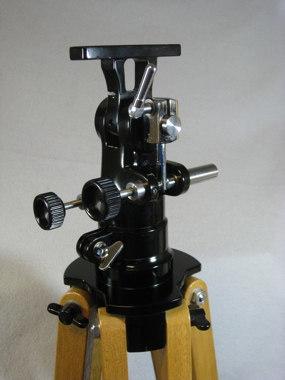
right side rear |
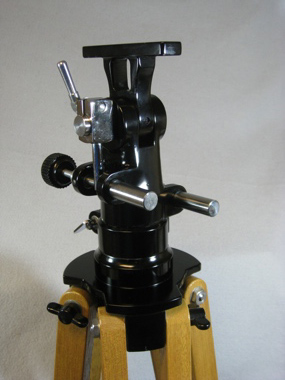
front right side |
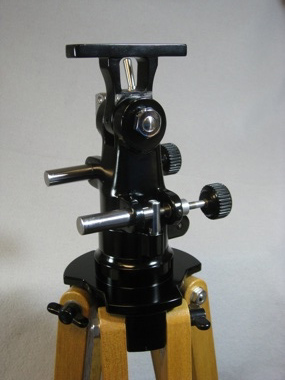
front left side view |
Above: Unitron Model 114 Mount Head - even after decades it inspires confidence and pride of ownership.
Click on images to see enlarged views (in order 182,568 then 184,143 and 182,549 bytes).
To set up the system first extend the tripod leg lower sections, then attach the legs brace. Then place the telescope optical tube mounting collar onto the mount saddle (the topmost flat section), attaching this by means of two hand knobs. Next the telescope is set onto the collar, slid front or back to its proper balance point, then swing the collar upper half down and over the telescope, secure the collar upper half to the lower half in place with the hand knob at the side of the collar.
Next loosen the clutches for azimuth (the flat stainless steel 'butterfly' handle near where the head and tripod meet), and for elevation (the cylindrical stainless steel knob near the saddle), moving the telescope up or down by hand onto the target. To make fine adjustments in either axis first tighten the clutches, then turn the black hand knobs on either side of the rear of the mount head. The manual geared controls are spring loaded tangent style drives, and so the mount can only be moved so far by these controls without loosening the clutches to manually reposition the telescope, an 'unwinding' the manual geared controls before resuming the tracking. When using the smaller telescopes it was a simple matter while at the eyepiece to reach forward to turn these controls to track an object, but mounts for the 4 inch and larger incorporated flexible cables or steel rods to facilitate this. By the 1970's competing geared continuously rotating mounts (most notably one by Nihon Seiko supplier Carton) were coming available. As functional as many later mounts are, none yet have been made that are as striking in appearance as those by Nihon Seiko.
Owing to the long length of the telescopes and fixed height of the tripod legs, people learned to work around the telescope standing when looking towards the horizon and possibly sitting on a low seat when observing objects overhead. This posed no major issues for most people and children when using telescopes of 3 inch and smaller. But by the time the design was scaled up to a 4 inch model, then when observing objects low in the distance shorter people would need to use a short step ladder to reach the eyepiece. But that is all part of the fun of having such a long optical tube to work around.
The Glory Days of Space and Unitron
Nihon Seiko and the distributors Unitron and Polarex were successful at promoting the refracting telescope as the vision of what an astronomical telescope should be. The telescopes were not only providing amazing views and images of the night sky, but people were using them for terrestrial uses, and even for decorating a home or office. Their numerous ads appeared in periodicals including: Sky and Telescope, Review of Popular Astronomy, and Science Digest.
While the 1950's were prosperous years for Unitron, in 1957 astronomy fever erupted with the launch of the Russian satellite Sputnik. The space race was on, and this drew national interest to space and science. The US space program was in full swing, and from it came real heroes and the country was unified with a national purpose. People and screen writers had imagination; television programs about astronauts, space and a bright future were on in prime time including Outer Limits, Twilight Zone, Lost In Space, My Favorite Martian, The Jetsons cartoon, I Dream of Jeannie, and of course Star Trek. Countless notable personalities including talk show host Johnny Carson, author Arthur C. Clarke, actor Marlon Brando, brought telescopes to the public attention. Even Dr. Wernher Von Braun, one of the preeminent rocket engineers of the 20th century, looked up to the Moon through his Questar 3-½ telescope. All while Unitron prospered.
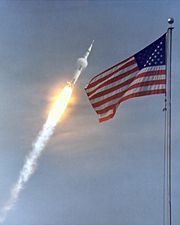 NASA's Apollo 11 with astronauts Neil A. Armstrong, Michael Collins and Edwin E. Aldrin, Jr. aboard, lifted off from Kennedy Space Center's Launch Complex 39A atop a Saturn V space vehicle at 9:32 AM EDT July 16, 1969 - the first Lunar landing mission. On July 20 their Lunar Landing Module descended onto the Moon touching down at 4:17:40 PM EDT (20:17:40 UTC). Many people around the world paused to share this televised moment live, and many more stayed up to watch Neil Armstrong step off the Lander and onto the Moon at 10:56 PM EDT (2:56 UTC) where he uttered "That's one small step for [a] man, one giant leap for mankind". Rarely since then has the world been so similarly united. (Audio file is .mpeg format 83,968 bytes)
NASA's Apollo 11 with astronauts Neil A. Armstrong, Michael Collins and Edwin E. Aldrin, Jr. aboard, lifted off from Kennedy Space Center's Launch Complex 39A atop a Saturn V space vehicle at 9:32 AM EDT July 16, 1969 - the first Lunar landing mission. On July 20 their Lunar Landing Module descended onto the Moon touching down at 4:17:40 PM EDT (20:17:40 UTC). Many people around the world paused to share this televised moment live, and many more stayed up to watch Neil Armstrong step off the Lander and onto the Moon at 10:56 PM EDT (2:56 UTC) where he uttered "That's one small step for [a] man, one giant leap for mankind". Rarely since then has the world been so similarly united. (Audio file is .mpeg format 83,968 bytes)
Left: Old Glory salutes the launch of Apollo 11 on July 16, 1969. The image size 5,840 bytes.
Click on image to see an enlarged view (762,206 bytes).
But other events were conspiring to distract America. The war in Vietnam cost so much in the way of lives, injury, and dollars that funding cuts for NASA loomed large. Budget and mission planning including the 'Mars Rocket', the hoped-for successor to the Saturn V, was stopped, etc. Administrators at NASA were wondering 'what next' as the finality of the last Apollo mission planned for 1972 set in. Executive and Legislative leadership became ineffectual distracted by the Watergate scandal while the US economy was feeling pressure from high spending, trade deficits, rising interest rates and energy costs - and the consumer was starting to feel it too.
The Changing Marketplace
 Unitron did not have much time to enjoy the fruits of the growing market since there were ominous signs on the horizon. Among these were an increase of tensions regarding competition and trade issues between the USA and Japan. These came to the limelight in 1969 when President Nixon and Japanese Prime Minister Sato met in Washington, DC on November 19, 20 and 21, to discuss world events and matters of mutual interests to the United States and Japan. The meetings included discussions about trade imbalances and trade liberalization - making Japan's markets more accessible for US products; this was not to be the last time these matters would come up so publicly. The discussions closed with an statement where parties agreed to 'try harder' (as usual when US trade representatives meet foreign delegations) to address the large imbalances in trade and payments between the USA and Japan. But more about this later.
Unitron did not have much time to enjoy the fruits of the growing market since there were ominous signs on the horizon. Among these were an increase of tensions regarding competition and trade issues between the USA and Japan. These came to the limelight in 1969 when President Nixon and Japanese Prime Minister Sato met in Washington, DC on November 19, 20 and 21, to discuss world events and matters of mutual interests to the United States and Japan. The meetings included discussions about trade imbalances and trade liberalization - making Japan's markets more accessible for US products; this was not to be the last time these matters would come up so publicly. The discussions closed with an statement where parties agreed to 'try harder' (as usual when US trade representatives meet foreign delegations) to address the large imbalances in trade and payments between the USA and Japan. But more about this later.
By 1970 it seemed as though any store that sold anything was offering some refracting telescopes, and these were nibbling away some of the market share for Unitron's smaller telescopes. One could buy a reasonably well made refracting telescope of up to about 75mm (3 inch) aperture at Montgomery Wards, Sears and Roebuck that bore store brand trade names. One could buy Monolux, Tasco, Jason, Bushnell, Swift, from the increasing number of catalog and chain stores. These telescopes originated in Japan and many were surprisingly well made given their selling price with optical tube assemblies made of metals with glass optical components, often sold in their own wood carrying case too. By the 1980's many of the lower priced telescopes transitioned to cheaper plastic components, some even with cheaply made plastic lenses, cardboard boxes were in and wood cases were history.
Competition from the many Japanese made achromatic refracting telescopes and from makers of other types of telescopes in the USA caused Unitron to gradually reduce their offerings. By 1970 the 1.6 inch Model 127 telescope was discontinued as few people were willing to spend $75 on a telescope this small no matter how well made. This left the 2.4 inch models as the smallest telescopes in the line. In 1970 the Model 114 sold for $125 in 1970, but by December 1972 the price increased dramatically, higher by about 1/3 to $165 for the set.
Some new domestic makers sprung up in Japan too, most notably Takahashi Seisakusho who in 1967 introduced their own TS65 2.6 inch refracting telescope with equatorial mount. Most of the Japanes telescope making companies that appealed to mass merchandisers competing on price disintegrated, leaving no dramatic impact on the market. However, Takahashi and another Japanese manufaturer Vixen Co., Ltd. would by 1977 jump on innovations that resulted from efforts by Nikon and Canon to improve their ultra-telephoto lenses. These companies, along with complacency at Nihon Seiko would ultimately destroy the f/15 maker's competitiveness; more about this later too.
Other competing designs prospered too, among these were Newtonian reflecting telescopes most notably the Criterion RV-6, a 6 inch f/8 telescope selling for $194.95, and introduced in October 1970 was the Criterion RV-8 a $399.95 8 inch f/6 telescope. Cave Optical Company was doing a good job of making telescopes that competed for the affections of astronomers who might otherwise buy one of Unitron's larger offerings. Edmund Scientific was moving from selling surplus components and optics to selling new telescope-making parts including mirrors and lenses, and complete telescopes. Of course Questar was still around, one of the few competitors still there since as far back as 1954, but their unique telescopes appealed to a clientele looking for something different than that which Unitron offered.
As images from space and the pace of life quickened through the later 1960's it seemed there was less and less that could be left to the imagination. A glimpse of Saturn appearing with modest details no longer had the impact on a person coming of age then that it might have had for people who grew up in the 1950's or earlier. By 1970 the American public had largely become used to space missions. When the Apollo 17 mission launched on December 7, 1972 this would be the last manned flight to the moon for that century as the originally planned following three missions had been cancelled as funding had been diverted. It is interesting commentary on the state of things when we recall many people telephoned their local television stations to complain when coverage of some Apollo missions interfered with routine programming!
New Competition: In 1977 Takahashi introduced the TS90, a 90mm (3.5 inch) f/11 Apochromatic refracting telescope. The TS90 was the first of a new breed of refracting telescopes* that were within grasp of the more demanding amateur. The doublet objective incorporates a crown element made of pure calcium fluorite, a synthetic grown under laboratory conditions. This design providing unprecedented clarity and freedom from false color (chromatism), and with a focal length nearly 2/3 that of a competing Unitron. This faster f ratio meant the Takahashi was more versatile, easier to transport, and its optical tube assembly could be mated to a lighter weight mount than that required to overcome the moment of the longer Unitron f/15 refractor. In 1981 Takahashi introduced their first 4 inch fluorite Apo, and at an even faster and more compact f/8 - with better performance and nearly half the physical length of a Unitron 4 inch f/15! By the early 1980's Vixen too featured well made fluorite doublet apochromatic telescopes (lens similarly sourced from a Canon subsidiary), most notably the highly regarded Vixen 102FL. This 4 inch f/9 was distributed throughout the Americas by Celestron, this was a notable step in popularizing the Fluorite Apo refracting telescopes.
-
*Let's not overlook the Carl Zeiss company was there well before the others. By 1886 Zeiss was manufacturing microscope objectives employing calcium fluorite (CaF2) elements. And their subsidiary Schott pioneered the making of high grade synthetic calcium fluorite. However, Zeiss had not really pressed their Apo lens technology into the amateur telescope market - yet.
In spite of the changing marketplace Unitron continued to promote the company and astronomy. Jim Mullaney became the consulting staff astronomer for Unitron, helping to keep the product in the forefront while helping their customers progress in the hobby for about a decade. Few other companies of the time could provide before or after sale support like this. This was in part why some people considered Unitron to be the Aston Martin of telescopes.
Not yet appearing to realize how the market was changing, Nihon Seiko introduced new telescopes - yeeeup more ACHROMATIC refracting telescopes: an 8" (200mm) and 225mm (8.86) that were sold by special order. By the time these large refractors came about the product line, as elegant as it has been, was obsolete. Apochromatic refracting telescopes were taking over the traditional refractor market; these newcomers were being made in larger apertures and with much faster focal ratios too. The Apos could be made with physical lengths about half as long and lighter in weight than the Unitron. The compact Apos worked just fine on more compact mounts atop a shorter and more readily accessible tripod or pier. So any money saved by buying the achromat instead of a more costly apochromat OTA was cancelled out by the greater cost of taller stands and heavier mounts needed for the longer achromatic telescopes; this is before moving or housing a large f/15 telescope is factored in.
The shorter focal length Apo telescopes (f/6 and some even faster) provide superior color correction and greater versatility than the f/15 Achromats both for visual and for astrophotographic uses. Just consider an f/7.5 telescope can show four times the area of sky that may be seen through an f/15 system. The response to these technology developments from Nihon Seiko was....nothing really. Even if vendors Unitron and Polarex attempted to bring the changes happening in the market to the attention of management at Nihon Seiko, nothing came of it. Throughout the 1970's and into the 1980's there was no successful effort to develop Apo lens technology, or to source more versatile Apo lenses from third parties. So Nihon Seiko telescopes did not change, Nihon Seiko mounts did not change, the accessories did not change. Instead of working to protect the market they had developed Nihon Seiko elected to continue with what worked for them in the 1950's. In retrospect it seems like Unitron was chopping away, but no chips were flying - they were basically stuck basically offering fine 30 year old technology.
Above: Unitron’s problem graphically represented: a Model 160 4 inch f/15 Photo-Equatorial telescope with provided mount and tripod (image 32,715 bytes).
Alongside is Vixen 102FL 4 inch f/9 Fluorite Apo telescope shown on Vixen GP equatorial mount and aluminum tripod (retracted), image size 13,789 bytes.
Telescope images are scaled to show the approximate differences in physical size.
Please do not get us wrong, we are not knocking these telescopes for fun. In their day these provided a good value and striking performance on the objects for which they were well suited. We are just trying to keep things in perspective here so that readers do not think they must run out and buy one of these 'classic' dinosaurs without comprehending what they may be getting themselves into.
In an effort to compete better in terms of portability by 1980 Nihon Seiko introduced their Models 131-C (3 inch) and 132-C (4 inch) 'folded' refracting telescopes. In this arrangement an objective lens is attached to the front of a short cylindrical tube assembly, the light from the objective is reflected by two tilted mirrors aligned within the optical tube so that the light cone exits the rear of the telescope. So the 3 inch optical tube for example now was only 19 inches long, about 1/3 the length of the conventional telescope, and 5 inches in diameter. The added complexity and cost of the two precision mirrors inside these folded telescopes however added cost (introduced at just under $700 for the Model 131-C 3 inch equatorial set) and weight to the otherwise simple refractor optical tube. By 1985 the 131-C set cost was $1,078 while the conventional 3 inch equatorial telescope Model 142 sold for $1,298, the difference attributable to the larger German mount provided with the Model 142.
What Company?: Changes of people and organization would be among the critical aspects to impact the company. The original United Trading Company and its descendants changed corporate identities and their locations of offices and distribution numerous times. In 1975 Lawrence Fine, the founder of United Trading Company, sold his interests in the company; he would die tragically two years later. By 1981 Unitron had been sold to Ehrenreich Photo Optical, a photographic equipment distributor. In 1982 Thomas A. Zappetti came to the company, he would control the helm of the Unitron companies through the end of telescope production to see it emerge as a well regarded distributor of microscopes and other instruments.
From 1975 on the Unitron companies distributing these telescopes appeared to change corporate identities as some people change shoes; this can be seen in the records of Corporations held by New York and other states where the respective entities operated. Consider how the company is represented in their literature at our archives:
The Demise
Nihon Seiko continued production even as Unitron was sold to a photographic equipment distributor in 1981. Unitron telescope sales group was no longer an independent entity, they had been relegated to something like a foster child as Unitron saw dollar signs by moving their attention to sales of microscopes and other equipment. Generally speaking the quality of the telescope and mounts was not cheapened over their years of production, though later in production some less obvious cost cutting was apparent to us. Consider their replacing the traditional leather strap provided for decades as case handles with a black flexible plastic strap. The smaller and cheaper latches on the cases of later production models. The 'UNITRON' labels on their cases were originally made of painted high relief stamped metal nailed onto the case, later production models bear a simpler flat painted stick-on label.
In order to have something to sell that was comparable to the lower-priced imported telescopes being marketed through the 1980's, Unitron ordered refracting telescopes of simpler construction. These telescopes were not made by Nihon Seiko, but were made by other vendors and are basically identical to the 'Department Store' models being sold at the time, and were a far cry from the values that up to then could be expected of the Unitron name. At least some of these were made for Unitron by Towa Optics of Japan. Towa sold telescopes under their tradename and under other trademarks through retailers in the USA, their telescopes included the 'Discoverer' line sold by Sears Roebuck. One of these Towa telescopes is a 20 to 90x zoom 60mm achromat on a simple alt-az mount bearing the trade name "UNITRON" on the focuser, and with "UNITRON ED-U-SCOPE™" on the barrel of the telescope optical tube. Trying to cash in on the 'Comet Halley' visit from 1984 to 1985, Unitron imported other less sophisticated telescopes some that made little sense for looking at Comet Halley. These included a 12 to 40x 40mm "Komet Spotter™"; this is among those many small telescopes being marketed then by people who knew nothing about observing comets to people who knew nothing about observing comets.

|

|
of that good old-fashioned American capitalism? (27,364 and 24,152 bytes).
But the items offered in the product line seemed less competitive at the time in the eyes of management at Company Seven that we had no interest in offering the Unitron telescopes even as we rode the crest of 'Comet Halley' visit from 1984 to 1985.
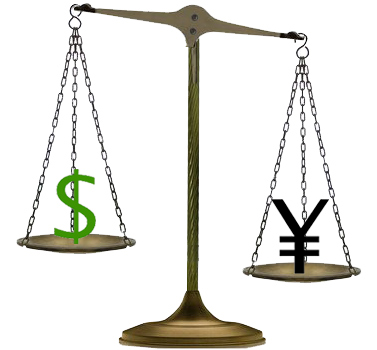 The decline of Japanese dominance in the US market under the administration of President Ronald W. Reagan, high spending in some areas, various exemptions to planned budget cuts and the loss of federal revenue from tax cuts created difficulties in balancing the federal budget. As a result, the government borrowed extensively to pay its bills issuing Bonds and the like. Government debt about tripled from 1980 to 1988. Much of this money came from abroad, especially from Japan. Borrowing money to pay the debt caused the government to spend a greater proportion of its budget on interest payments for loans. The budget deficit kept interest rates so high that the value of the dollar soared in relation to major foreign currencies. Consumer spending for manufactured products grew, but this was mainly spent for inexpensive imports. As a result the United States further increased its foreign debt throughout the 1980s by spending more on imported goods than it earned from exports. The U.S. trade deficit climbed from $24.2 billion in 1980 to $152.7 billion in 1986. By 1986 with James Baker as Treasury Secretary, an effort began to reduce foreign indebtedness, the government devalued the dollar. Devaluation, which lowered the value of the dollar in relation to foreign currency, made American products less expensive and therefore more desirable in foreign markets. During the next few years, the dollar declined in value by over 40% on a trade-weighted basis and encouraged a major revival of US exports. However, devaluation failed to erase the trade deficit.
The decline of Japanese dominance in the US market under the administration of President Ronald W. Reagan, high spending in some areas, various exemptions to planned budget cuts and the loss of federal revenue from tax cuts created difficulties in balancing the federal budget. As a result, the government borrowed extensively to pay its bills issuing Bonds and the like. Government debt about tripled from 1980 to 1988. Much of this money came from abroad, especially from Japan. Borrowing money to pay the debt caused the government to spend a greater proportion of its budget on interest payments for loans. The budget deficit kept interest rates so high that the value of the dollar soared in relation to major foreign currencies. Consumer spending for manufactured products grew, but this was mainly spent for inexpensive imports. As a result the United States further increased its foreign debt throughout the 1980s by spending more on imported goods than it earned from exports. The U.S. trade deficit climbed from $24.2 billion in 1980 to $152.7 billion in 1986. By 1986 with James Baker as Treasury Secretary, an effort began to reduce foreign indebtedness, the government devalued the dollar. Devaluation, which lowered the value of the dollar in relation to foreign currency, made American products less expensive and therefore more desirable in foreign markets. During the next few years, the dollar declined in value by over 40% on a trade-weighted basis and encouraged a major revival of US exports. However, devaluation failed to erase the trade deficit.
We would see the steady decline in US buying power accelerate so that by 1988 the exchange rates were at about 128 Yen per dollar!
By 1985 the price of the Unitron Model 114 2.5 inch telescope had increased to $585, this was before the major effects of the devaluation hit. Company Seven observed the price of the highly regarded Japanese made products skyrocketed. The more demanding members our community did not suffer much from the loss of many items since more and more of the better products were coming from innovative US companies. However, the more economical to advanced range of refracting telescopes and equatorial mountings in particular became much more expensive commodities with few available substitutes for similar cost in the USA. This devaluation did have the impact desired initially, we slowed buying Japanese products. But the US companies did not bring back much production to the USA on the whole - they simply looked for countries where things could be made for less than Japan. It is interesting to note that Edmund Scientific then decided to bring the complete manufacturing and assembly of the Edmund Astroscan telescope back to the USA; the result was such a plunge in quality control that Company Seven discontinued selling the popular little telescope!
Just as Japan had been teased for its mimicking of foreign made innovations in the mid to late 1980's, Taiwan and Korea then in the late 1980's China made their entrance onto the world optics markets. The products that would displace Nikon Seiko other Japanese manufacturers on the low to middle range of the markets were coming from Korea, Thailand, China. These imports would for several years to come be among the shoddiest products sold to the uninformed US consumer.
By the late 1980's the Chinese and Korean factories developed telescopes and mounts that so closely copied the external appearance (but not the performance) of competing products where the external resemblance is often so exact that only the paint can differentiate them. Vixen in particular suffered greatly as many of their products were copied in appearance if not performance. By 1988 the pace of manufacturing telescopes had appreciably slowed at Nihon Seiko as demand for Japanese made goods declined. Those who made the better, more sophisticated apochromatic refracting telescopes and accessories in Japan (Takahashi for example) prospered. Some Japanese companies began to shift their own production to overseas thus saving labor and real estate costs, and also avoiding having to deal with more stringent environmental laws taking effect in Japan. Nikon opened a plant in Thailand, Fujinon shifted some production to China; others would follow. The companies making the simpler achromatic refractors in other countries quickly took much of the available market share from Carton, Kenko Co., Ltd., of Vixen, other Japan-based factories and of course Nikon Seiko.
By 1990 Celestron who had been selling capable Vixen telescopes such as the 80mm Alt azimuth Refractor for about $550 was faced by Meade Instruments, their prime competitor, advertising a poorer quality 90mm achromatic telescope made in Korea selling for much than the Celestron (Vixen) 80. As a warning to our customers Company Seven mentioned in our web site "a very good 80mm telescope will outperform a lesser grade of 90mm telescope in many areas of astronomy". However, the typical consumer when poorly counseled and otherwise ignorant of details will usually choose that which appears to be the "best buy", and so the sales of imported Japanese made telescopes plummeted.
By 1992 Unitron was no longer in the telescope business, but continued to sell off remaining telescope and accessories inventory for years afterwards. By the late 1990's a large facility was all that remained, with bits of this or that telescope here and there. By this time most US based manufacturers of good amateur telescopes who operated from the 1950's through the 1970's had gone out of business with the exceptions of Celestron International and Meade Instruments. And neither Celestron or Meade would survive as independent US manufacturing companies beyond 2007. Celestron was sold to a Chinese manufacturer, while Meade exported production to Mexico and China; artifacts of the unfortunate US administrations decisions - remember H. Ross Perot's comment about 'Giant Sucking Sound'?
There is one noteworthy U.S. company who have endured since 1954, and this is Questar Corporation of New Hope, PA. Known for making the 'Rolls-Royce' of precision compact telescopes, they have endured since 1954 by not tampering much with what makes a Questar great - and by not having to answer to Wall Street.
| Optical Tube Assembly | Altazimuth Mount with Tripod, Cases | ||||||||||||||||||||||||||||||||||||||||||
|
The Internet continues to evolve and bring the world closer than ever, among the benefits are all the resources that helped one to not only find these telescopes used, or rare parts to make restore them, but also literature. Here are Unitron documents scanned by the host of this site:
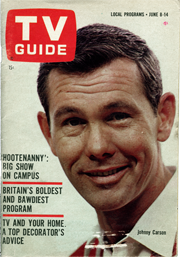
Contents Copyright 2010 - 2017 Company Seven and respective contributors - All Rights Reserved


